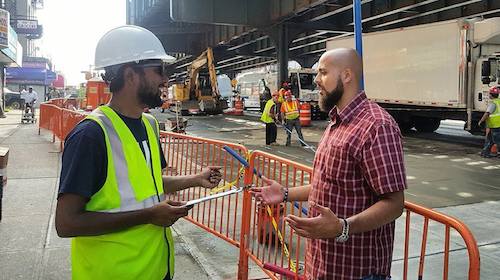The position of district leader doesn’t usually attract much attention in election coverage or amongst voters. It is unpaid, listed low on the ballot, and doesn’t involve direct legislative power. Despite this, Michael Beltzer, a 30-year-old independent democrat in the 85th Assembly District, has dedicated much of the last year to campaigning for the job. The race pits him against longtime incumbent, Marcos Crespo, who is also the assemblyman for the district, chairman of the Bronx Democratic County Committee, and chairman of the Puerto Rican/Hispanic Task Force.
It’s a David versus Goliath contest with low stakes, but Beltzer said it’s important to challenge the party machine.
“The way leadership has traditionally been is that there’s very consolidated power, a very top-down kind of hierarchy,” he said. “That’s where I have real fault with the leadership style in the Bronx. We can’t keep the next generation at bay.”
Beltzer said his goal in the campaign is less about winning and more about showing that it’s possible for politically engaged citizens – not just established party members – to run for local positions. “It’s a test of pure electoral politics,” he said of the race.
The role of district leader as Beltzer sees it, is to be “the eyes, ears and voice of the community.” But in the South Bronx, where voter turnout is notoriously low, there’s a bit more to it. In addition to monitoring and raising community issues to elected officials, district leaders are responsible for staffing poll sites for elections.
If a district leader is also running for Assembly, this is particularly advantageous. “If you do your work correctly, you can go into the election with 300 votes in the bag,” said Michael Benjamin, retired Assembly member for the 79th district.
Beltzer, a Long Island native, moved to the South Bronx in 2007. He got his start in New York politics working for John Liu on his 2009 campaign for comptroller, where he discovered the importance of making direct contact with individual voters. “You could tell that nobody really touched them, they never really met politicians, they didn’t know how do access local government,” he said.
He sees the role of district leader as an opportunity to close the gap between residents and their elected officials. “Your elected official should come to your tenant association meetings, be at your church events, and be at the park having conversations,” he said.
Beltzer has taken a very hands-on approach to canvassing. He collected all of his own signatures for his nomination petition, and spent weeks meeting residents and registering them to vote.
He is fearless about approaching people, is unfazed by rejection, and recites his introductory spiel perfectly every time. It begins with description of the position, with an emphasis on the fact that it’s unpaid, and includes a reference to the fact that his 6-year-old daughter goes to school in the district.
The official requirements to run for district leader are very straightforward – be a resident of your district, be registered democrat and get 500 signatures on a nominating petition – but getting on the ballot without County support in the Bronx is not an easy task. The nominating petitions of non-party candidates are often heavily scrutinized for cases of voter fraud – if a signature or an address doesn’t look quite right, it can easily be discarded. Given this, it is advisable to collect double the required of signatures, if not more, on nominating petitions (Beltzer collected 1500 signatures on his petition). Without a campaign staff, this is a labor intensive and time-consuming process. In addition to this, candidates need to have the resources to defend their petitions in court if accused of voter fraud. Because Beltzer isn’t working full-time at the moment, he was able to dedicate more time to this process than some of his contemporaries.
Candidates who are endorsed by the Bronx Democratic County Committee, on the other hand, can tap into the party’s manpower, legal, and financial resources.
“If you run against County, you’re not running against an individual,” said Julio Pabón, who ran for council and lost twice against County-backed candidates.
As a member of the Bronx Young Democrats, Beltzer initially tried to get County support for his campaign. He pitched the idea of running for district leader to his assemblyman, Marcos Crespo, the current district leader, in 2014. Eventually, though, he decided to run on his own. “I couldn’t just sit out a year, wait my turn, do things the ‘right’ way,” he said. Assemblyman Crespo could not be reached for this story at the time of publication.
Because of the difficulties associated with running against County endorsed candidates, few independents have tried to run in the past, allowing many officials to keep their positions for decades at a time. In the 2014 New York State primaries, the incumbent reelection rate was 96.67%. In next today’s election, however, there are several unaffiliated candidates who are challenging County-backed incumbents.
While chance of any of these candidates winning is low, they say the act of running – and providing an alternative to voters – is powerful in itself. For democracy to work, Pabón said, “we need to run people for every position – from dogcatcher up to US senators.” The challengers say they hope that by campaigning hard, registering people to vote, and raising community issues, incumbent candidates will be forced to do more on-the-ground work too.
For Michael Beltzer, if he is able to make any impact on the polls the campaign will have been worth it. “If we see an increased voter turnout,” he said, “there’s power in that and people will pay attention.”


